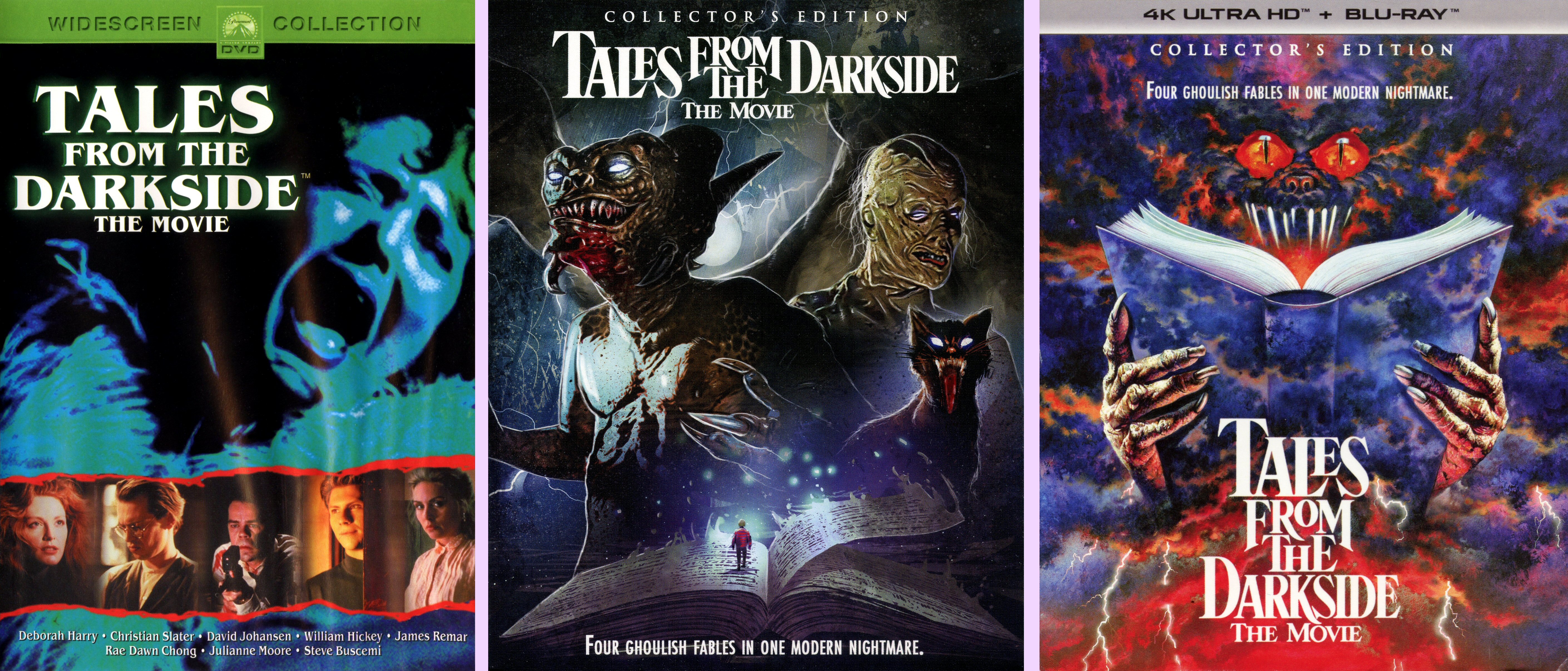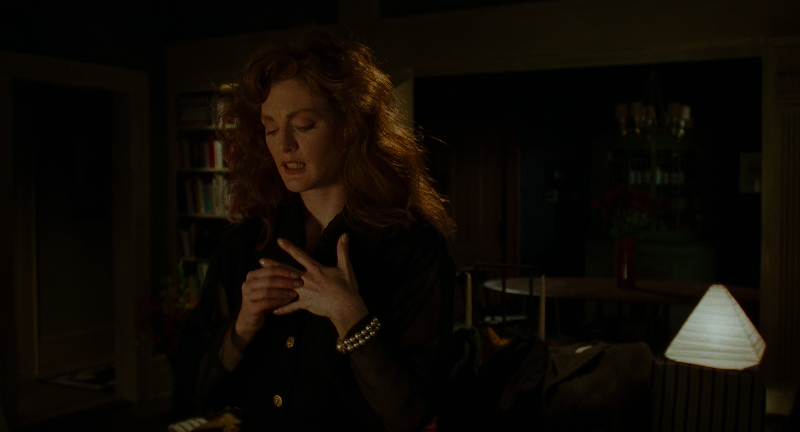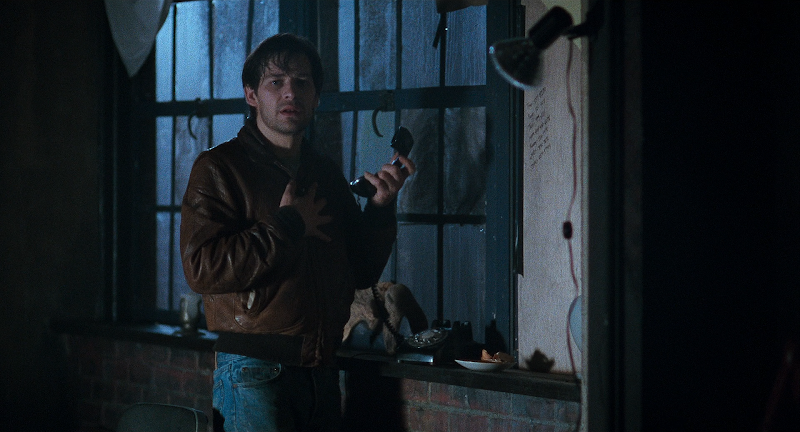Update 9/7/20 - 11/30/23: Three years feels a little fast for a double-dip of the same movie from the same movie, but what the heck? Scream Factory has now updated Tales with to UHD with an all new scan, so let's see how it looks.
Like the show, this film is a horror anthology, very much in the vein of Creepshow. That's because it's George Romero and co again, still working with Stephen King. In fact, the Tales series was originally conceived as a Creepshow show, but they dropped the IP and comic book angle due to rights conflicts. In fact, I'd say this is an even better unofficial follow-up than the proper Creepshow 2. This time it's three stories, plus a wraparound (deflatingly titled "The Wraparound"). The writing, production values, style, music and cast are all on fire this time around. The highlight is definitely Romero's adaptation of a King short story where Buster Pointdexter is surprisingly effective as a hitman hired to kill Darkside alum William Hickey's cat. But the opener, a clever mummy story very much in the EC vein starring Christian Slater (who got his start in an episode of Tales), Steve Buscemi and Julianne Moore, is almost as great. The weakest link is a the last story, which tries and fails to invest you in a flat and very 80s love story, playing like Scorsese's New York Stories segment minus all the drama. But even that one's got a super cool, life-size animatronic monster and a charming supporting appearance by Robert Klein. This worst segment could be a lot of movies' best.
Tales From the Darkside: The Movie debuted on DVD from Paramount in 2001. It's been reissued a few times over the years (there was the burning book cover in 2006 and a 3-disc triple feature with Graveyard Shift and April Fool's Day in 2007), but it's always been the same disc. Which was actually pretty fine: anamorphic widescreen with an audio commentary by George Romero and director John Harrison. But it's been calling out for an HD upgrade for a long time, and preferably a more substantial special edition to boot, and Scream Factory finally answered the call in the summer of 2020 with their new collector's edition - the film's long-awaited blu-ray debut. And now, in 2023, they've already updated it to a new BD/ UHD combo pack with a fresh scan and everything, so even the two 1080p blus should be different.
 |
| 1) 2001 US Paramount DVD; 2) 2020 US Scream Factory BD; 3) 2023 US Scream Factory BD; 4) 2023 US Scream Factory UHD. |
Oh look! Now they have sprung for a new transfer. I can kinda see why they didn't bother in 2019, since that transfer doesn't look so different from what we have now in 4k. Like we don't suddenly see a whole bunch of picture information we couldn't before, and the 1.85:1 composition is virtually identical (closely examine the bottom edge, and you'll see it's shifted very slightly). But there's no denying this is an improvement. Even when just comparing the two blu-rays, the new one really captures and renders all the grain, which was much spottier in 2019. The colors look a little more natural, if muted, on the new blu, but they come to life on the UHD. It's not exactly an explosion of saturation, but even subtle colors like the books on the shelf way behind Moore are more vivid now. More obvious, though, is detail that had previously been washed out in the brights, like the lampshade in the first set of shots, has been recovered on the new 2023 transfer.
And here's another nice advantage with SF's new edition. The DVD features a new 5.1 remix that makes a lot of changes to the regular mix (which Harrison made himself and is quite happy with). So that's cool. But unfortunately, Paramount forced the choice on us by eliminating the original theatrical stereo track. But both of Scream's editions includes both, naturally bumping them up to lossless DTS-HD in the process. All four discs also include optional English subtitles.
Again, Paramount's DVD wasn't completely unsatisfying in terms of special features either. Besides your basic trailer and chapter insert, they provided an audio commentary with Romero and Harrison. It starts a little slow, and at first you might be worried this is going to be one of those dry tracks with a lot of dead air. But soon enough they get into it, become much more conversational, and the insights don't stop until the final credit.
Thankfully, Scream Factory has held onto that commentary (and the trailer). But they've also come up with a whole bunch more. The jewel in this crown is a new, feature length documentary from Red Shirt, that talks to pretty much all the major players in the crew (the director, producer, DP, set designer, all three KNB guys, the stunt man who played the monster and the stars of the final segment, James Remar & Rae Dawn Chong). It's arbitrarily broken up into six segments with no "Play All" option, but that's a tiny nitpick of a thorough and absorbing exploration of this film's origins and production. Also included is a new audio commentary with producer David R. Kappes, but perhaps should have been an on-camera interview rather than a commentary, since they rarely focus on what's happening on-screen. Finally, there's a fun collection of behind-the-scenes footage captured by KNB on VHS, a couple stills galleries, radio spots, TV spots, reversible artwork and a slipcover.
Scream's 2023 hangs onto all of that and adds a new audio commentary by podcasters Emily Higgins and Billy Dunham, which I can't say I got much out of. They mostly just point out all of the things they like, and they liked everything. Even so, they managed to have consistent gaps of dead air in the back half of the film. So no real value added there. But this release does come in a much better slipcover using the classic artwork, so that's a plus.
But before I leave you, I'd also like to talk about the original Tales From the Darkside... the TV series, which ran from 1983-1988. It was originally released on DVD by Paramount season by season from 2008-2010, eventually combined into a boxed set in 2010. Paramount's since reissued the full series as a budget set in 2016, but apart from some funky casing (the disc trays don't actually connect to the outer shell, they just float inside it), it's the same 12 discs with the same extras, original disc labels and everything.
As you'd expect from an anthology series, it's uneven. Some big name directors (Romero, Bob Balaban, Tom Savini) and writers (Stephen King, Clive Barker, Robert Bloch) touch some episodes, but not many others. The show is surprisingly packed with stars... some stalwart character actors doing their normal runs though 80s television, some rising stars before they were famous, some industry friends, and some flashy "big gets." The production values are consistently low, though. Most episodes consist of two to four characters in a single, one-room set, and outside of a few showpiece episodes, even with the good ones, you can feel the crew was just pounding these episodes out at a breakneck pace. Some episodes go for a scary, horror atmosphere, others are quite silly; you never know what you'll get week to week, ranging from a delightful surprise to something pretty rough and tedious. Kareem Abdul Jamar could be playing a wacky genie or a young woman could be tormented by a small monster in Fritz Weaver's creepy boarding house. In general this series wound up playing like a lower budget Twilight Zone than anything, with no particular genre but replete with the big twist endings.
 |
| 2020 US Paramount/ CBS DVD. |
The audio's alright, though. A fairly clean and easily listenable Dolby Digital mono track in 2.0. There are no subtitle options, of course, but there are a few extras.
For starters, we get a George Romero commentary over the pilot. It's good... during the portions of the show he speaks. Romero's audio regularly starts and stops, as if the plan was for him to just comment over clips from the episode and make that a featurette. That would make sense also because, in season two, there's a featurette just like that, where he comments over clips of another episode. It makes for a bit of a frustrating listening experience, but it's still a treat to get to hear Romero reminisce about his show, even if the presentation is borked. The season 2 one winds up only running five minutes, but at least it's a lot tighter. The only other extra consists of two episodes of another anthology (no, not Monsters) made by the same team... an untitled series that never aired. These episodes are pretty good, with slightly higher production values. They're not better than the best episodes of TFtD, but they could play in the top 20% or so, and it's a nice treat to see them preserved here (in the same quality as Tales).
So there was no question that Scream's new UHD is now the definitive edition of The Movie, which is a real expectation-exceeding affair. 2020 to 2023 is a short time for a double-dip, but it was sort of asking for a new scan, so I can't say this wasn't welcome, especially since we're moving up to a higher gen release anyway. And the new commentary didn't do much for me, but hey, more is still better than less. As for the series, there's no difference between the new and old DVD sets, except that the new budget edition's price makes the show, despite its flaws in content and home video presentation, hard to resist. Both are easy recommendations from me. And remember... "The dark side is always there, waiting for us to enter, waiting to enter us. Until next time, try to enjoy the daylight."








































































